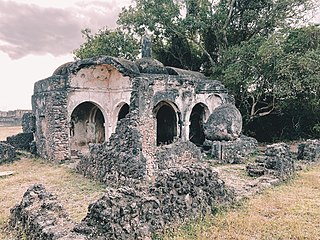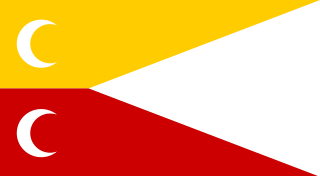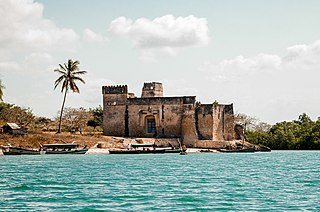
Kilwa Kisiwani is an island, national historic site, and hamlet community located in the township of Kilwa Masoko, the district seat of Kilwa District in the Tanzanian region of Lindi in southern Tanzania. Kilwa Kisiwani is the largest of the nine hamlets in the town of Kilwa Masoko and is also the least populated hamlet in the township with fewer than 1,000 residents.
The Swahili people comprise mainly Bantu, Afro-Arab and Comorian ethnic groups inhabiting the Swahili coast, an area encompassing the Zanzibar archipelago and mainland Tanzania's seaboard, littoral Kenya, northern Mozambique, the Comoros Islands and Northwest Madagascar.

Zanj was a name used by medieval Muslim geographers to refer to both a certain portion of Southeast Africa and to its Bantu inhabitants. This word is also the origin of the place-names Zanzibar and the Sea of Zanj.

The Mosque-Madrasa of Sultan Hasan is a monumental mosque and madrasa located in Salah al-Din Square in the historic district of Cairo, Egypt. It was built between 1356 and 1363 during the Bahri Mamluk period, commissioned by Sultan an-Nasir Hasan. The mosque was considered remarkable for its massive size and innovative architectural components, and is still considered one of the most impressive historic monuments in Cairo today.

The Mosque of Ibn Tulun is located in Cairo, Egypt. It is one of the oldest mosques in Egypt as well as the whole of Africa surviving in its full original form, and is the largest mosque in Cairo in terms of land area. It is built around an open square courtyard which allows natural light to travel through. Ibn Tulun Mosque features ancient architecture styles of Egypt, its decorations being created from carved stucco and wood. This mosque is a popular tourist attraction.

The Lamu Archipelago is located in the Indian Ocean close to the northern coast of Kenya, to which it belongs. The islands lie between the towns of Lamu and Kiunga, near the Coast Province. It is a part of Lamu District.

Kilwa Masoko or Masoko is an administrative ward in Kilwa District of Lindi Region in Tanzania. The ward covers an area of 200 km2 (77 sq mi), and has an average elevation of 11 m (36 ft). The ward is also the capital of Kilwa District. According to the 2012 census, the ward has a total population of 13,601.

Swahili architecture is a term used to designate a whole range of diverse building traditions practiced or once practiced along the eastern and southeastern coasts of Africa. Rather than simple derivatives of Islamic architecture from the Arabic world, Swahili stone architecture is a distinct local product as a result of evolving social and religious traditions, environmental changes, and urban development.
Sultan al-Hasan ibn Sulaiman, often referred to as "Abu'l-Muwahib", was a ruler of Kilwa Kisiwani, in present-day Tanzania, from 1310 until 1333. His full name was Abu al-Muzaffar Hasan Abu al-Muwahib ibn Sulaiman al-Mat'un ibn Hasan ibn Talut al-Mahdal.

The Kilwa Sultanate was a sultanate, centered at Kilwa, whose authority, at its height, stretched over the entire length of the Swahili Coast. According to the legend, it was founded in the 10th century by Ali ibn al-Hassan Shirazi, a Persian prince of Shiraz.
Dr. Neville H. Chittick was a British scholar and archaeologist. He specialized in the historic cultures of Northeast Africa, and also devoted various works to the Swahili Coast.

The Swahili coast is a coastal area of East Africa, bordered by the Indian Ocean and inhabited by the Swahili people. It includes Sofala ; Mombasa, Gede, Pate Island, Lamu, and Malindi ; and Dar es Salaam and Kilwa. In addition, several coastal islands are included in the Swahili coast, such as Zanzibar and Comoros.

Somali architecture is the engineering and designing of multiple different construction types such as stone cities, castles, citadels, fortresses, mosques, temples, aqueducts, lighthouses, towers and tombs during the ancient, medieval and early modern periods in Somalia and other regions inhabited by Somalis, as well as the fusion of Somalo-Islamic architecture with Western designs in contemporary times.

The "Shirazi era" refers to a mythic origin in the history of Southeast Africa, between the 13th century and 15th century, as recorded in the 15th century Kilwa Chronicle. Many Swahili in the central coastal region claim that their towns were founded by Persians from the Shiraz region in the 13th century.

Songo Mnara is a historic Swahiili settlement in located on Songo Mnara Island in Pande Mikoma, Kilwa District in Lindi Region of Tanzania. The island is home to a Medieval Swahili stone town. The stone town was occupied from the 14th to 16th centuries. Songo Mnara has been recognized as a UNESCO World Heritage Site, along with nearby stone town Kilwa Kisiwani. In total, archaeologists have found six mosques, four cemeteries, and two dozen house blocks along with three enclosed open spaces on the island. Songo Mnara was constructed from rough-coral and mortar. This stonetown was built as one of many trade towns on the Indian Ocean. The site is a registered National Historic Site.
Shanga is an archaeological site located in Pate Island off the eastern coast of Africa. The site covers about 15 hectares. Shanga was excavated during an eight-year period in which archaeologists examined Swahili origins. The archaeological evidence in the form of coins, pottery, glass and beads all suggest that a Swahili community inhabited the area during the eighth century. Evidence from the findings also indicates that the site was a Muslim trading community that had networks in Asia.

Pemba Island is a large coral island off the coast of Tanzania. Inhabited by Bantu settlers from the Tanga coast since 600 AD, the island has a rich trading, agricultural, and religious history that has contributed to the studies of the Swahili Coast trade throughout the Indian Ocean.
Sanje ya Kati is protected, uninhabited historic site located on Sanje ya Kati Island in Pande Mikoma ward in Kilwa District in Lindi Region of Tanzania's Indian Ocean coast. The site is home to medieval Swahili ruins that have yet to be fully excavated.

Fort Santiago is the name of a former Portuguese military installation in the island of Kilwa, in Tanzania. It's nowadays known as Arab Fort or Gereza Fort. It is situated between the Makutani Palace and the Great Mosque.

Kua or Ruins of Kua is a Medieval Swahili, National Historic Site located in Jibondo ward of Mafia District in Pwani Region of Tanzania. The site is located on Juani Island of the Mafia Archipelago. As of 2016, the site is currently on the list of 50 at-risk cultural heritage sites in 36 countries.

















